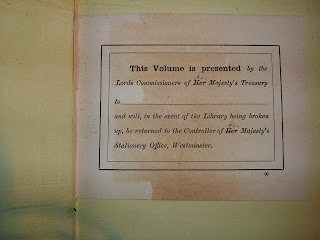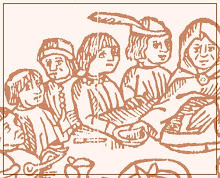It contained a book, entitled:

This is the 1889 edition of the chronicles of Adam of Murimuth, perhaps the most level-headed and well-informed of all chroniclers of Edward II's reign. And yet, so far as I have been able to find, no edition has been published since, and it has never been translated. I don't aspire to remedy the first - yet - but the second I can and will do.
And if I think it's good enough, and think myself capable of undertaking the full exercise, I will go on and do everything necessary to make a critical edition in both languages, for my MA or PhD.
So yes, it is a very exciting parcel, particularly as it was a long hard search through the dark and woodsy wilds of the internet to find it. It's kind of out of print, after all.

The book is exciting enough from a codicological perspective, never mind the contents. The edges are rubbed, the spine a little cracked where it connects to the front cover, and it will need careful handling, but nothing serious. And if it becomes serious, it can be rebound. The pages are in perfect condition - and I mean perfect, which I will get to with delight in a minute. The pastedowns are thin enough that I can see quite clearly the binders' methods inside the front and back covers. The first and last pages bear the imprint of "Wigan Free Public Library", and inside the front cover someone has jotted in lead pencil "228 - FP".
But the two most exciting features are, firstly, this little insert:
Why is the "to" space blank? Was it not presented, in the end, or did someone just forget to fill in "Wigan Free Public Library"? Does the same insert appear in every volume of this publication? The slip is glued into the spine, but after binding. Were any copies for public sale, as the printer's note on the title page implies, or was the distribution of them entirely within the gift of the Treasury? If not entirely, what percentage? And - Her/His! Victoria died in January 1901, so this presentation must have been very shortly after that - so soon that they were still using the stacks of these slips printed off before her death, and amending them by hand (in black ink, slightly faded to brown). And did the Library break up? Was it returned to the royal Stationery Office, Westminster? I got it from Abebooks.com, an online American amalgam of various secondhand and rare books stores - specifically, from Second Story Books in Rockville, MD (whatever MD is - no, I don't have America's states' abbreviations memorised, and I don't believe many Americans have Australia's states' abbreviations memorised either, and we have far fewer). I think I shall write a slip containing my information, the year and reason I bought it, the source and the condition it is in now, and attach it under the first slip. Some books deserve to have their histories known.
The second and perhaps most exciting thing is the state of the pages. No one has ever read this book before. Look:

Save for the first quire, and one quire later on in the book, none of the pages have been cut. This presents me with a dilemma. I have to cut it myself if I want to read it. But in doing so, I will be spoiling its uncutness. I will be submitting it to common use.
The solution, I have decided, is to find a beautiful old penknife that is worthy to cut it, and to use that to cut only the pages of Murimuth's chronicles, leaving Avesbury's intact. Such a wonderful and unique surviving feature of a volume cannot be completely obliterated in the name of vulgar research, after all!
And, just a thought. Why is it that Edward II's chroniclers largely deplore him and, at best, either tolerate him or describe him with relish as a martyr and, in doing so, present a really unflattering and graphic picture (hi, Geoffrey le Baker!), while his son's chroniclers entitle their works things like "De Gestis Mirabilibus Regis Edwardi III"? He should have made favourites of men who were better at PR. Like Roger Mortimer.
... Well, he was. Until the power went to his head and he started setting himself up as the new King Arthur.
Also, because these were on my camera though I do not remember taking them, have some pictures of two much adored beagles. My lad, Oliver, is on top so that he can cuddle her better because he thinks she's the best thing ever, and my sister's girl, Solace, is snuggled in under her with the self-satisfied and rather coy expression of someone who has a man to look after her but has him right under her thumb, thank you. Except when she looks at me, when she takes on her pleaselove/feedmeI'lldoanything look. Beagles do that look very well. I think it's the ears. Also, that's a girl who knows how to apply (and use!) her eyeliner. While Oliver looks cheerfully and sleepily oblivious to feminine wiles, so long as he has a nice warm Solace-smelling body to cuddle.






.jpg)


9 comments:
Oooh, how exciting to get such a wonderful book! I really appreciate Murimuth's chronicle, though he does make errors - like saying that John Maltravers was one of Ed's murderers, which he wasn't. And that comment that abbots, knights etc viewed Ed's body superficialiter - what's that all about, Adam, eh?? Why so cryptic?? :-)
Love those adorable doggies!
Oh, there's always errors. I get the impression Edward III was quite happy to let Maltravers be thought to be one of the murderers, but just let him hang around in exile until the fuss died down.
And that superficialiter is indeed the word on which entire theories of the royal succession could be built. :)
What a nice purchase! (And what nice beagles!)
They are indeed the best beagles ever, except for Solace's habit of uprooting my tomato seedlings to see if there's anything interesting to eat underneath them, and Oliver's habit of eating the leaves of my cabbages. :) And completely infatuated with each other.
Lovely book...and I applaud your translation project! Some of us amateur/arm-chair medievalists don't read Latin at all (*gasp*).
Very cute beagles too. I had a beagle when I was growing up named Pumpkin. She was a real sweetie.
What a fantastic book to have in your possession - and a great project too! For those of us who struggle with Latin translation, it's always a happy day when someone takes on the task!
And those doggies are gorgeous too. What lovely eyes they have!
Beagles are lovely dogs and deliberately cultivate their lovely eyes and lovely ears for begging purposes. It's a breed specialty. :)
Translations definitely have their place, even if it's just in helping historians skim-read quicker to find the right place so they can locate the latin they want to quote. Especially for long works like chronicles, where there are fewer pitfalls of the artistic type you get in translating, say, poetry.
Definitely not about to try translating Sir Gawain any time soon.
Truly, a wonderful book. I believe that portions of Murimuth were translated for Edward III and his wars, 1327-1360 by Sir W. J. Ashley (London : D. Nutt, 1887, reprint Tonbridge, Kent : Pallas Armata, 1992). I faced a much worse case of uncut pages when I got an uncut copy of Early Yorkshire Charters via interlibrary loan. I needed the information on those pages, but it was not my book. Need won. I do hope you carry though with your translation project. I, for one, would buy a copy. MD, by the way, is Maryland, and you are right about Americans. Not only can I not name the Australian state abbreviations, I would not wager on my ability to name all of the Australian States.
Oh dear. What an excruciating dilemma. :(
Thank you - I did read through most of that book a year ago, but I had forgotten it had Murimuth bits in it. I'll track it down again.
And there you are, I have learned one American state abbreviation today. :)
Post a Comment